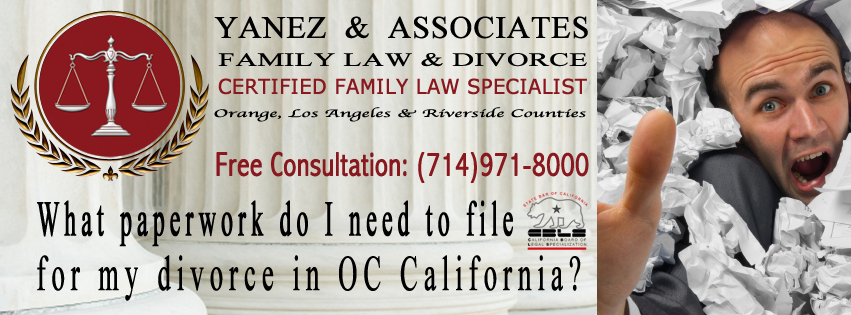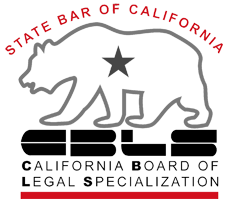What Paperwork Do I Need to Complete to File my Divorce in Orange County, California?
What documents to file for my dissolution of marriage. Whether you are filing for divorce on your own or you are working with an attorney, there are specific forms you will need to fill out accurately and file or deliver based on specific deadlines.
Because a simple mistake can be costly in a divorce, it is in your best interests to discuss your case with a qualified divorce lawyer in Orange County prior to submitting your divorce forms.
Petition - To end a marriage or a domestic partnership in California
This is the first form you will need. It provides the court with the most basic information about your marriage or your domestic partnership, and what you would like to change about your legal relationship.
• Are you filing for dissolution (divorce), a legal separation, or an annulment?
• Do you meet the residency requirements for a divorce in California?
• On which date did you marry or register your domestic partnership and on which date did you separate?
• Do you have minor children? If so, it requests information like their age, sex, birth date and names.
•What are your grounds for divorce, legal separation or annulment?
• California is a no-fault divorce state, so listing irreconcilable differences is an option.
• For an annulment, you will need a specific reason that makes your marriage eligible for annulment.
• The petition lists information about child support, which is a state requirement if you share children.
• You will have to answer basic questions about spousal or partner support and property and debts. Discuss this portion with your attorney, as mistakes here could cost you.
• You may also request that the other party to pay for your attorney fees, or that you volunteer to pay the other party’s fees, and if you changed your name, you may change it back to your previous name.
Summons - For both parties
This form lists some basic rules, through general restraining orders, which you and your spouse or partner must follow. During the divorce process, these rules can restrict what you can do with your money, property, debts and assets, and disallows either party from moving out of California with your shared children or applying for new passports for shared children without either a court order, or the consent of the other parent.
Property Declaration - An extension of the Petition
If you did not have enough room on the property section of your Petition to list all of your property, including vehicles, bank accounts, insurance policies, retirement and pension funds, etc., this form allows you to expand your list.
Most people will need to fill out this form, because there is very little space allotted in the Petition.
Declaration Under Uniform Child Custody Jurisdiction and Enforcement Act (UCCJEA)
This form is required if you and your spouse or registered domestic partner have shared children who are under the age of 18 at the time of your divorce, legal separation or annulment. It requests the following information about each of your children:
• The child’s name,
• The child’s place of birth,
• The child’s birth date,
• The child’s sex,
• The child’s current address and the amount of time the child has lived there,
• The person the child lived with at that address, and the child’s relationship to that person,
• Up to three previous addresses for the child.
It also requests information about previous custody cases in California or in other states regarding the children listed in the form. It also asks about current domestic violence restraining orders or protective orders that may be in place.
Child Custody and Visitation Application Attachment - Optional
If you want the Court to make child custody and visitation orders for your family, you should fill out this form. You do have other options for creating your own child custody and visitation agreement, so it is best to discuss this with your divorce attorney prior to submitting it to the court.
This form asks who to create a proposed custody and visitation order, including who you think should have both physical and legal custody of your child, and if you choose sole custody, whether or not the noncustodial parent should have visitation rights. You can also propose a custody and visitation schedule, and list people and places that are in your child’s life or who will help get your child from one parent to the other.
This form might be helpful for you to review on your own or with your attorney if you are creating a custody agreement on your own, because it will tell you what the court is looking for, including things like traveling with children, child abduction prevention, and varying schedules for holidays.
Remember that when you are creating a potential child custody schedule for your children, what you say now matters. Do not create a schedule out of spite: it is not in the best interest of the children and will not be approved by the courts unless the other parent poses a danger to the children. Custody matters are always based on the best interest of the children.
Review, File and Serve
Review
Once you have completed the forms listed above, you will need to have an attorney review them for errors, and make sure that you do not have any additional local forms to fill out. If you want temporary orders regarding child support, spousal support, finances, or domestic violence, you will have more forms to fill out, but your lawyer can help you determine if these are right for your situation or not.
File
In addition to the original form, you’ll need two copies: one for you and one for your partner or spouse. These forms will need to be filed with the court clerk, who will keep the original and return the originals to you. At this point, you’ll need to pay a filing fee.
Serve
All of the forms that you filed with the court will need to be delivered to the other party, in addition to a blank Response form for your spouse or registered partner to fill out. If you and your spouse or your partner share children, you will also need to sent a blank Declaration Under Uniform Child Custody Jurisdiction and Enforcement Act (UCCJEA), which is the same as the UCCJEA you filled out and filed with the court.
You will either need a person who is over 18 years old who is not involved in your divorce to serve the divorce papers on your spouse or registered domestic partner, or you will need that person to mail them first class so that you receive a receipt upon delivery. If you and your spouse are on good terms and you agree to it, you may choose to send papers through the mail, and upon receipt, file a Notice of Acknowledgement of Receipt.
Once your spouse or registered domestic partner has been served, the server must file a Proof of Service of Summons. It is important to make sure that this form is filled out correctly, so check with your divorce attorney before filing it.
The Next Step in a Divorce

You will have to wait 30 days from the date that your spouse or registered domestic partner was served so that he or she has the opportunity to respond. You have the option to request temporary orders if you wish to, but discuss these options with your attorney prior to submitting paperwork.
Declaration of Disclosure | Schedule of Assets & Debts | Income and Expense Declaration - Property division
Within 60 days of filing your petition with the court, you will need to file a Declaration of Disclosure, which includes three forms: a Declaration of Disclosure, a Schedule of Assets and Debts, and an Income and Expense Declaration. This is a way for you and your spouse or domestic partner to let one another know what you own, what you owe, what is community property and what is separate property. This is necessary in order to divide your property and debts.
You should also include Tax Returns for the last two years.
It is not possible to divorce in California without exchanging this form with your spouse or partner.
Your case may or may not require a Preliminary Declaration of Disclosure and a Final Declaration of Disclosure. These forms do not need to be filed with the Court, but they do need to be served upon the other party in the same manner as the petition and summons were served.
Declaration Regarding Service of Declaration of Disclosure
This form lets the court know that you have given your Declaration of Disclosure to your spouse or partner.
Completing Your Divorce

Depending on whether your spouse or partner responds to your paperwork and how her or she responds, you will have different paperwork to fill out in order to complete your divorce. Your divorce attorney is your best resource in determining the best way to handle your case as it plays out.













